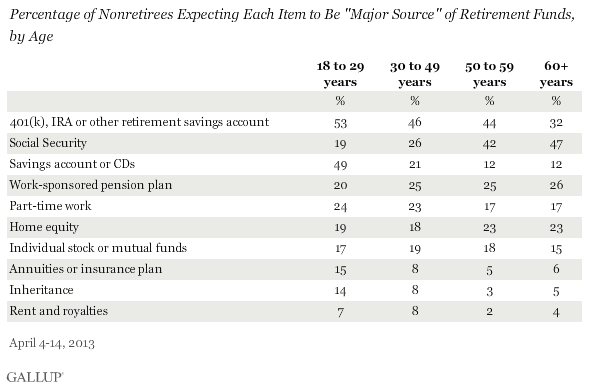AARP Hearing Center
A Retirement Reality Check, Courtesy of Gallup
By Patrick Kiger, May 23, 2013 02:30 PM
Thinking about your eventual retirement? If you're relatively well-off, you're probably confident that your tax-deferred savings will provide your major source of income. But if you're at the other end of the income ladder, you're more likely to count on Social Security benefits to tide you over.
Those are some of the findings of a newly released Gallup poll that reveals glaring contrasts between how nonretired Americans from different income levels expect to fund their retirement years. The key takeaways:
- Among Americans with a household income of $75,000 or more, a solid majority of 65 percent expect to rely on their own retirement savings in IRAs, 401(k) plans and other tax-deferred savings vehicles, while another third are counting on a employer-sponsored pension. Only 17 percent expect Social Security to be their major income source.
- Middle-income Americans - defined in this poll as those with family incomes from $30,000 to $70,000 a year - are split more evenly, with 44 percent expecting to rely on tax-deferred retirement accounts, 33 percent counting on Social Security, and 26 percent expecting to support themselves with part-time work. Only 22 percent think that they'll rely mostly on an employer-provided pension.
- Of those with family incomes of $30,000 or less, 42 percent envision that they'll rely on Social Security benefits. Another 27 percent expect that they'll get by primarily through part-time jobs, slightly more than the 26 percent who are counting mostly on IRAs or 401(k)s. Only 15 percent of the least-wealthy Americans are counting on employer-provided pensions.
The survey also reveals that many Americans probably haven't come to terms with the economic realities of retirement. Overall, for example, about one in five Americans expect to support themselves in retirement primarily through part-time work. But according to the Social Security Administration, relatively affluent retirees must generate at least 65 percent of their pre-retirement income level to maintain their standard of living, while less-well-off Americans - who need to spend more of their income on necessities - may have to take in as much as 90 percent of what they made before retirement. What's more, they're likely to find it difficult to make that much, particularly if they're at the lower end of the economic ladder, because Bureau of Labor Statistics research shows that workers in part-time positions usually earn significantly less per hour than full-time workers.
AARP Retirement Calculator: Find out if you're saving enough
Additionally, about the same number of retirees - 20 percent - expect to live primarily on the home equity that they've accumulated. But that may require them to sell their homes and downsize to a condo or rented apartment, or move to a less-expensive part of the country.
As Louisiana-based financial planner John H. Gin notes, fluctuations in the real estate market can erode the value of that nest egg, and a homeowner with a paid-off mortgage may have to add rent to his or her monthly expenses. "If you plan to tap your home's value to support your retirement, proceed with caution," he writes. "Remember that the primary function of your home is to provide a roof over your head, and using equity to fund retirement requires careful planning."
Finally, age also appears to significantly influence an individual's retirement outlook. Have a look:

Also of Interest
- Recession Will Haunt Us Into Retirement
- How Much Income Will Your 401(k) Provide?
- Join AARP: Savings, resources and news for your well-being
See the AARP home page for deals, savings tips, trivia and more































































